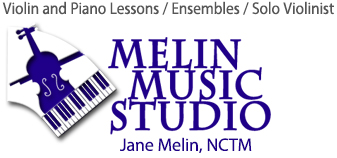These pieces are good goals for high school students with 6-10 years of violin study to aim to learn by the time they graduate. Students considering going on to study violin performance in higher education will eventually tackle even more advanced repertoire, listed at the end of this page.
GOALS: Fluent playing over the entire range of the instrument. Some experience with virtuosic bowings like firm staccato, flying staccato, and jeté. In-depth familiarity with scales, arpeggios and double stops such as those in Flesch Scale System and other equivalent studies. Familiarity with musical forms and styles of different periods. Awareness of notions in music theory and harmony and their relationship to interpretation. Students should be encouraged to develop their own interpretation of repertoire.
- Baroque repertoire in the advanced levels often has extended double-stop passages featuring counterpoint (2 melodies playing at once). The Bach Unaccompanied Sonatas and Partitas are core repertoire at the top 3 levels.
- Classical works by Mozart and Beethoven should be explored by every student.
- Romantic advanced repertoire often consists of show-pieces composed to spotlight the violinist’s technical skills. Sometimes the musicality of the piece can be overshadowed by the showoff factor. Be sure you choose pieces that appeal to you melodically, or have technical flair that you would like to learn to play (such as gypsy-style), or you may grow tired of working on the piece before you have mastered it.
- Selections from the Contemporary period often feature complex harmonies and dissonances. It is good to explore this music to broaden your horizons and prepare for orchestral playing or auditions; choose at least one piece between Level 7 and Level 10 in this genre.
Requirements:
One fast concerto movement and two other pieces in contrasting style. One of the three pieces should be contemporary or impressionistic (Debussy et.al.). Three composers should be represented. All memorized. Level 10 With Honors if a complete Mozart, Bruch, Mendelssohn or Wieniawski concerto is learned or 3 mvts of Lalo; With High Honors if complete concerto is memorized. Pieces marked with * or ** are considered core repertoire; choose at least one piece that has a */**.
**These are Mrs. Melin’s favorites from the core repertoire.
List A: Fast Concerto Movements
Baroque Period
Spohr: Concerto No. 8 in Am, Op. 47 (Kalmus)
Classical Period
*Mozart: Violin Concerto No.4 in D (w/ cadenzas)
*Mozart: Violin Concerto No.5 in A (w/ cadenzas)
Romantic Period
**Bruch: Concerto No. 1 in Gm, Op. 26
Conus Violin Concerto
*Lalo: Symphonie Espagnole, Op. 21
**Mendelssohn: Concerto in Em, Op. 64
**Saint-Saens: Introduction and Rondo Capriccioso
*Sarasate: Zigeunerweisen
Wieniawski: Concerto No. 2 in Dm, Op. 22
Contemporary Period
Barber Violin Concerto, mvt. 1
**Bartok: Roumanian Folk Dances, play four.
Kabalevsky: Concerto in C, Op. 48
List B: Shorter Pieces
Baroque Period
*Bach: Solo Sonatas and Partitas: one movement
Romantic Period
Brahms: Hungarian Dances, Bk. 1, Nos. 1-10; Bk. 2, Nos. 11-21
Brahms: Sonatas, Op. **78, 100, 108
Debussy/Heifetz: Beau Soir
Debussy: Clair de Lune
Debussy: La Fille au Cheveux de Lin
Debussy/Heifetz: L’Apre-midi d’un Faune
Faure: Sonata in A
**Franck: Sonata in A
Kreisler: Caprice Viennois
Kriesler: Tambourin Chinois
**Kroll: Banjo and Fiddle
Sarasate: Romanza Andaluza, Op. 22, No. 3
Contemporary Period
Bartok: Rhapsody #2
**Copland: Hoe Down from “Rodeo”
Gershwin/Heifetz: My Man is Gone Now (From Selections from “Porgy and Bess”, Chappell)
Hindemith: Solo Sonatas, Op. 31, 1 & 2 (Schott)
Ibert: Caprilena
Kabalevsky: Rondo
Milhaud: Le Printemps
Prokofiev: Five Melodies, Op. 35
Prokofiev/Grunes: March from “Love for Three Oranges”
**Prokofiev: Masks from “Romeo & Juliette”
Stravinsky/Dushkin: Chanson Russe
Webern: 4 Pieces, Op. 7
COLLEGIATE REPERTOIRE (most-performed professional solo repertoire)
The concerto sequence prescribed by Dorothy Delay divides the professional concerto repertoire into three groups. All the Level 10 repertoire above is in Group I. “Level 11” might include the remaining Group I concertos by Dvorak, Vieuxtemps, Saint-Saens and Paganini. Group II includes the concertos by Tchaikovsky, Sibelius, Brahms, and Beethoven which are studied as part of a university level violin performance major. Group III concertos are works by Berg, Walton, Elgar, Stravinsky, Shostakovich and other 20th century composers which explore the outer limits of violin technique and tonality.
